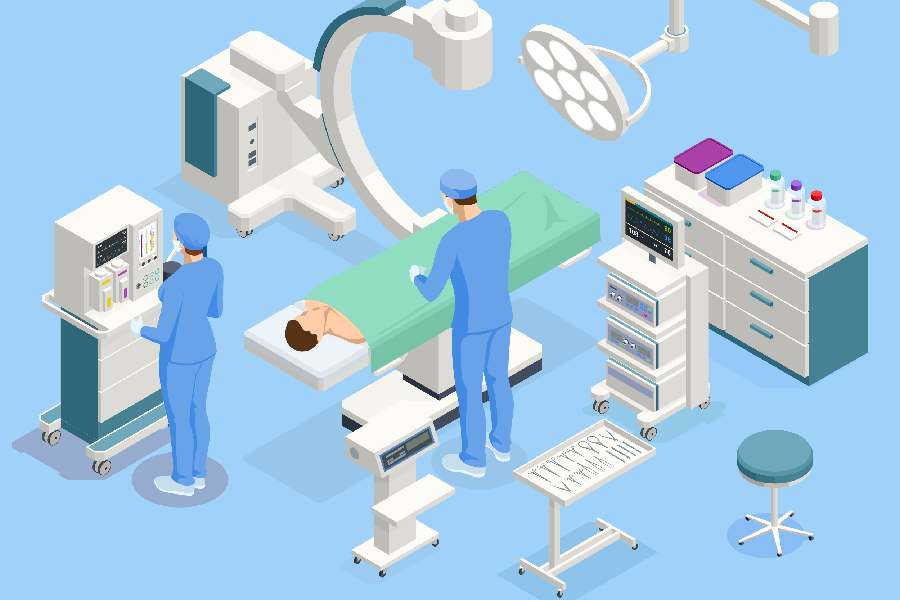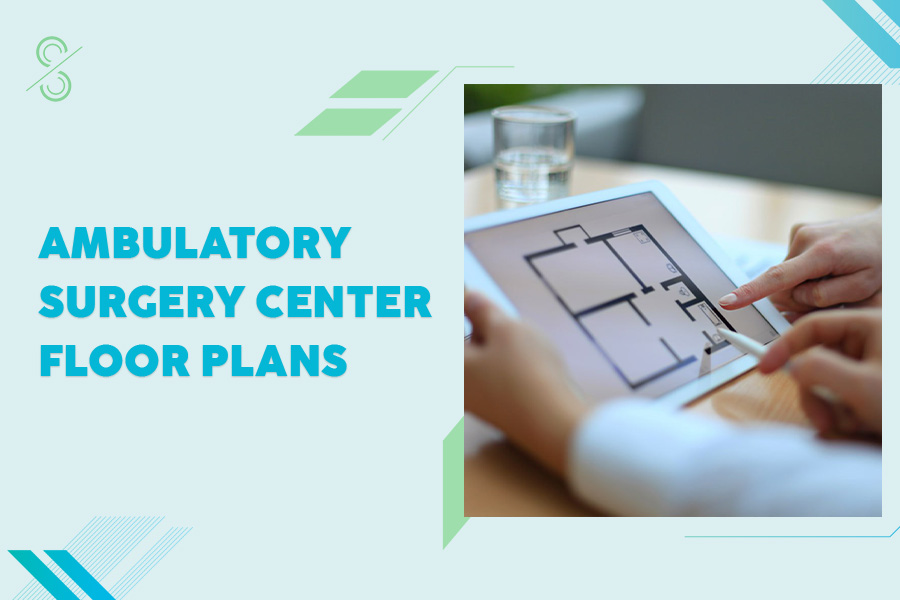Ambulatory Surgery Center Floor Plans
Correctly positioning your ambulatory surgery center is extremely important. Although the ambulatory surgery center floor plans are different, building your facility according to the latest design guidelines is important.
In this article, we will explain the most important things you should consider when drafting your floor plan. In addition, we have some handy tips on making the facility efficient for the medical staff and easy to navigate for the patients.
Let’s take a virtual tour around the ASC floor plans and figure out the latest design requirements.
Short Overview of the Ambulatory Surgery Center Floor Plans
Before you start planning the layout design, you must know what rooms you should include in the plan. All ambulatory surgery centers should have enough space to accommodate the following areas and rooms:
- Lobby area
- Reception area
- Waiting room
- Public restroom
- Patient restroom
- Consultation rooms or conference room
- Nurse station
- Exam rooms
- Pre-op rooms
- Operating room
- Recovery rooms
- Staff lounge and kitchen
- Staff dressing rooms
- Offices
- Sterile instrument storage
- Central supply and equipment storage
- Medical records storage room

Layout Design of Ambulatory Surgery Center
The layout design of the ASC will mostly depend on the parcel you purchase and the shape of the building. Remember that the ASC should be in an area zoned for medical use.
Regarding the shape of the building, ASCs are generally square or rectangle-shaped. But which one is the more effective?
If the parcel space allows it, we recommend opting for square shaped building. The square shape allows the architect to create a layout design with a circular process flow.
On the contrary, the rectangle-shaped ASCs are long and narrow. Hence, they require more walking. With more walking, you might lower staff efficiency and increase the chances of patients having lower satisfaction rates.
When you are planning the layout design, you should focus on ensuring the facility will be functional and efficient. Some tips from the best Surgery Center consultants are:
- Have a big parking lot;
- Business offices should be close to the patient check-in;
- Place the scheduler near the ORs;
- Build a small medical records storage room;
- ORs shouldn’t be placed near the property line;
- Leave space for the anesthesiologist to move around;
- Ensure a good flow for gurneys;
- Reduce the chance of cross-contamination by making the rooms accessible without entering the surgical department;
- Processing should be near supplies and receiving, and
- Place the sterile processing near the ORs.
Functional Areas
The functional areas of the ASC include multiple types of rooms inside and outside the facility. When patients come to your ASC, the first thing they see is the parking lot.
When you are planning your ambulatory surgery center floor plans, you need to make the building entrance easily noticeable from the parking. If the parking space is large, include signs to help patients and visitors enter the facility fastly.
Reception and waiting areas
According to the Guidelines for Design and Construction of Outpatient Facilities, the reception and waiting areas are public. So, when you are planning the layout and constructing the facility, you should ensure they are freely accessible to everyone.
Since the reception is a public area, you need to make the process of registering the patient as private as possible. Some ASCs prefer to divide the waiting areas and reception with glass for more privacy. On the other hand, other ASCs arrange the sitting in the waiting area to be further away from the reception.
According to the Centers for Medicare and Medicaid Services regulations, the waiting room must be separate from the recovery room. Plus, they can’t be shared with another healthcare facility.
Some ASC take it a step further and eliminate the waiting room. They build activity areas and kiosks instead of dull waiting rooms.
Preoperative spaces
The preoperative spaces are also called pre-operative holding areas. It is advised for the pre-operative rooms to be closer to the operating rooms. This makes the patient’s experience more convenient and the overall work of the ASC more efficient.
The patients won’t have to move around often after the medical staff prepares them for surgery. The preparation room should have all the necessary medical equipment. Also, some ASCs include lockers where patients can lock their belongings.
Pre-op areas can be private or shared. Typically, in the ASCs, many patients are coming and going on the same day. That’s why many facilities have shared pre-op areas with cubicle curtains.
However, there are several ASC where the pre-op room is private. But, the same room is used for postoperative care for the patient in it pre-op.
The preoperative holding areas should be close to the nursing staff and under their direct visual control. Moreover, the pre-op rooms need to have enough handwashing stations to establish a high level of cleanliness and high hygiene levels.
Besides the strict guidelines of the preoperative holding areas, the exam rooms need to follow specific criteria during the building process. According to the 2022 design guidelines, the exam/observation room for one patient should have dual entry.
The single-patient exam room should be a minimum of 100 square feet with at least two feet minimum clearance and eight inches at the sides. Additionally, there should be one-foot free space from the exam table.
On the other hand, the standard exam rooms in ASC should be at least 80 square feet.

Operating rooms and procedure rooms
The first rule about operating rooms in the ambulatory surgery center floor plans is that they should be in a restricted area. ASCs are required to have at least one operating room in the facility.
The estimated sizes of the operating room depend on the surgical procedures they are built for and the required staff. An inpatient operating room should be at least 400 square feet.
However, the standard OR is around 500 square feet. Here are the average sizes of ORs according to the medical area they are used in:
- Orthopaedic – 600 square feet
- Cardiac – 600 square feet
- Neurological –600 square feet
- Hybrid – 650 square feet
The OR should be designed to accommodate all the necessary equipment for the type of surgeries that will be conducted in it. In the ASC, there should be 100 square feet of clean and sterile supply storage per operating room.
The room should be constructed according to the standards for humidity and temperature. Also, there should be a place in the OR for emergency disinfection and sterilization of the operating room materials.
Support areas
The support areas are divided into three categories:
- Support areas for patient care units, treatment, and diagnostic areas,
- Support areas for patients, families, and visitors, and
- Support areas for staff.
Compliance with Regulatory Standards
The layout of the ASCs must be done according to various government standards. Most of them are to ensure the patient gets high-quality care in a safe environment.
The regulatory standards that need to be followed by the ASCs are:
- Proper licensing and certification for work,
- Accreditation,
- Anesthesia safety,
- Patient privacy,
- Quality improvement,
- Emergency preparedness,
- Health Insurance Portability and Accountability Act,
- The standard for access to care and continuity of care (ACC),
- Patient and family rights regulations,
- Standards for assessment of patients,
- Surgery care standards,
- Prevention and control of infection standards,
- Fire safety programs,
- Management of information requirements etc.
Meeting building codes and regulations
The ASC floor plans must be done according to the building codes and regulations. Typically, these vary depending on the state, but the most common aspects that must be taken into consideration are:
- Structural integrity,
- Fire safety,
- Ventilation,
- Accessibility for people with disabilities,
- Electrical systems regulations,
- HVAC systems,
- Security measures,
- Water safety and more.
Accommodating accessibility requirements
The support areas must be designed according to the Americans with disabilities act and other similar disability laws. Hence, the support rooms should be accessible to people with disabilities.
Accessible entrances, exits, hallways, patient rooms, restrooms, and parking lots are required. Aside from ramps and elevators for people with mobility impairments, patient information and communication materials for people with visual disabilities are recommended.
Designing for Safety and Efficiency
Infection control measures
Every ASC should have an infection control program. The program should be ongoing, integrated into the QAPI program, and written according to the national infection control guidelines.
The infection control program of the ASC should be comprehensive and effective and include the following:
- Ways to provide a sanitary environment for surgical services,
- How to avoid transmission of infections,
- Guide on how to identify, prevent and manage infections within the facility, and
- Mechanisms for improving the control of infection.
Additionally, the ASC is responsible for conducting monitoring activities within the facility. The healthcare facility should be able to identify the risks of infections.
Adequate storage space
You will have to build multiple rooms for storage. One is for keeping medical records and other documentation, while the other should be for storing equipment and supplies.
When designing the ASC floor plan, we advise you to have a small room for medical records. With such advanced technology, most records and documentation can be electronically stored. As a rule of thumb, you should have enough storage to put the paper charts dating one year back.
As for the equipment and medical supplies storage, you need to have enough space to store the gurneys that are not being used, the towers, C-arms, etc. The entire equipment should be easily accessible.
Separate storage rooms are recommended for anesthesia supplies, pharmaceuticals, IV solutions, syringes, protective equipment, and other medical supplies.
Technology Integration and Infrastructure
Build the new ASC considering the fact that technology will change. To make the future remodeling process easier, plan stub outs for electrical and gas infrastructural changes.
Flexibility for changes
The ASC needs are constantly changing. That’s why the infrastructure of the ASC should be easily adaptable. But how can you build the ASC with the ability to convert the environment to new uses simply?
- Make the layout with permanent major corridors. But make corridors that allow growth and change.
- Design multi-use spaces and utilize modular planning.
- Plan soft spaces that are easily relocatable.
- Plan for easy expansion.
- Use interstitial instead of high-tech spaces.
- Consider modular utility systems.
Patient-Centered Design Considerations
Don’t forget about the patient experience when building the ambulatory surgical center. You should spend time finding the right decor for the public areas. For instance, try to make the reception and waiting areas comfortable and filled with plenty of natural light.
Some of the ways you can increase the natural daylight in all the areas of the ASC are:
- Using light wells,
- Interior courtyards,
- Windows in ORs,
- Windows in north-south directions,
- Shading devices to redirect and diffuse daylighting, and
- Clerestory windows in the patient recovery area.
Throughout the whole facility, you should put clear signage. That will help all the patients and visitors find what they are looking for. The layout of the ASC should ensure a streamlined patient flow. Don’t forget about the discharge process and arrange easy pick-up of the patients.
Be flexible and open to change. Set feedback mechanisms to learn about the patient’s experience in your ASC.
Other design considerations to make patient’s experience better are:
- Efficient check-in and registration,
- Friendly staff,
- Waiting areas with natural light and calming atmosphere,
- Off-stage delivery and storage supply areas.

Final Tips for Planning Ambulatory Surgery Floor Plans
When you are designing the ambulatory surgery center floor plans, you should follow the government regulations but also adapt the plan according to the needs of the organization and staff.
For instance, the government regulations are that you must have at least one operating room in a single-specialty ASC, and it should be 270 square feet. However, those are just the minimums. You can design a bigger OR if the surgical procedures and medical staff require more space for efficient work. Moreover, if you have enough case volume, you can plan two or more ORs.
Consult with your medical staff how you can build the facility to meet their needs. Getting their input can help you design the facility to make their job easier, which might increase the effectiveness.
When you are doing the ASC layout, consider the flow of the staff and patients. Everything that they need should be close to them.
Furthermore, you should have in mind future expansions. Whether you need an extra OR or want to shift from single to multiple-specialty ASC, design the facility so it is expandable, and adaptable to changes.
Consider the design
Another important thing is to look at multiple designs. Don’t rush the process, so you are not put in a situation where you have to remodel or have to deal with regulation issues. At best, consult with different architects and try to implement the best ideas from multiple layouts.
Most importantly, the hospital floor plan and construction should be done according to the estimated case volume. You need to ensure you have enough pre-op and post-op space to accommodate the patients until they are discharged. Building the right-sized ASC is of significant importance.
Conclusion
Well-designated floor plans, experienced medical staff, and the quality of care directly influence patient satisfaction rates. Following our tips for designing the ambulatory surgery center floor plans will make you one step closer to achieving your mission and vision.
Follow the latest trends if you want your name to be known in the business for quality care and considered by others as serious competition. Our final advice is to take your time and consult with us if you want expert advice and guidance through the whole process.





